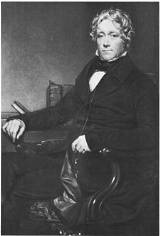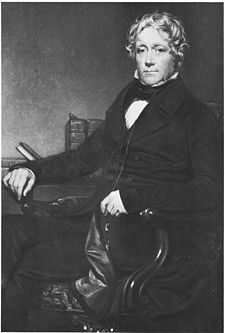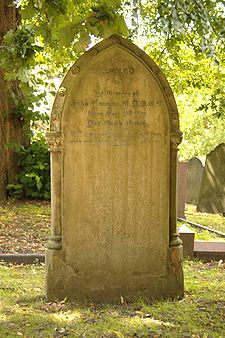
John Conolly
Encyclopedia

England
England is a country that is part of the United Kingdom. It shares land borders with Scotland to the north and Wales to the west; the Irish Sea is to the north west, the Celtic Sea to the south west, with the North Sea to the east and the English Channel to the south separating it from continental...
psychiatrist
Psychiatrist
A psychiatrist is a physician who specializes in the diagnosis and treatment of mental disorders. All psychiatrists are trained in diagnostic evaluation and in psychotherapy...
, was born at Market Rasen
Market Rasen
Market Rasen is a town and civil parish within the West Lindsey district of Lincolnshire, England. It lies on the River Rase northeast of Lincoln, east of Gainsborough and southwest of Grimsby. According to the 2001 census, it has a population of 3,200....
, Lincolnshire
Lincolnshire
Lincolnshire is a county in the east of England. It borders Norfolk to the south east, Cambridgeshire to the south, Rutland to the south west, Leicestershire and Nottinghamshire to the west, South Yorkshire to the north west, and the East Riding of Yorkshire to the north. It also borders...
, of an Irish family. He spent four years as a lieutenant in the Cambridgeshire Militia
Cambridgeshire Militia
The Cambridgeshire Militia was a militia regiment in the United Kingdom from 1759 to 1881, when it was amalgamated into The Suffolk Regiment.The regiment was organised in 1759. It was embodied in 1778, at which time it was ranked the 31st regiment of militia, and remained active for five years...
and lived for a year in France before embarking on a medical career.
He graduated with an MD
Doctor of Medicine
Doctor of Medicine is a doctoral degree for physicians. The degree is granted by medical schools...
degree at University of Edinburgh
University of Edinburgh
The University of Edinburgh, founded in 1583, is a public research university located in Edinburgh, the capital of Scotland, and a UNESCO World Heritage Site. The university is deeply embedded in the fabric of the city, with many of the buildings in the historic Old Town belonging to the university...
in 1821. After practising at Lewes
Lewes
Lewes is the county town of East Sussex, England and historically of all of Sussex. It is a civil parish and is the centre of the Lewes local government district. The settlement has a history as a bridging point and as a market town, and today as a communications hub and tourist-oriented town...
, Chichester
Chichester
Chichester is a cathedral city in West Sussex, within the historic County of Sussex, South-East England. It has a long history as a settlement; its Roman past and its subsequent importance in Anglo-Saxon times are only its beginnings...
and Stratford-on-Avon successively, he was appointed professor of the practice of medicine at University College, London, in 1828. In 1830 he published a work on the Indications of Insanity, and soon afterwards settled at Warwick
Warwick
Warwick is the county town of Warwickshire, England. The town lies upon the River Avon, south of Coventry and just west of Leamington Spa and Whitnash with which it is conjoined. As of the 2001 United Kingdom census, it had a population of 23,350...
.
In 1832 in co-operation with Sir Charles Hastings and Sir John Forbes
John Forbes (physician)
Sir John Forbes FRCP FRS was a distinguished Scottish physician, famous for his translation of the classic French medical text, De L'Auscultation Mediate by René Laennec, the inventor of the stethoscope...
, he founded a small medical association with a view to raising the standard of provincial practice called the Provincial Medical and Surgical Association. His brother William Brice Conolly became the association's 'Widows and Orphans Benevolent Fund' treasurer and secretary. In later years this grew in importance and membership, and finally became the British Medical Association
British Medical Association
The British Medical Association is the professional association and registered trade union for doctors in the United Kingdom. The association does not regulate or certify doctors, a responsibility which lies with the General Medical Council. The association’s headquarters are located in BMA House,...
.
Conolly and Forbes went on to start a new publication in 1836: the 'British and Foreign Medical Review, or, A Quarterly Journal of Practical Medicine', for which they shared the editorship from 1836 to 1839.
It was the first publication of its type, being aimed at sharing newly won medical knowledge with all its readers. The Review was read widely in Europe and America, and helped to promote modern methods of treatment and to enhance the reputation of British medicine. The BMA library still holds a complete set of its volumes.
In 1839, Conolly was appointed resident physician to the Middlesex County Asylum
Hanwell Asylum
The County Asylum at Hanwell, also known as Hanwell Insane Asylum, and Hanwell Pauper and Lunatic Asylum, was built for the pauper insane and is now the West London Mental Health Trust ...
at Hanwell
Hanwell
Hanwell is a town situated in the London Borough of Ealing in west London, between Ealing and Southall. The motto of Hanwell Urban District Council was Nec Aspera Terrent...
(now known as West London Mental Health NHS Trust's St Bernard's Hospital
St Bernard's Hospital
St Bernard's Hospital is the only civilian general hospital in the British overseas territory of Gibraltar.-Juan Mateos:In 1567, during Gibraltar's Spanish period, a retired Spanish innkeeper by the name of Juan Mateos converted his house into a 20 bed hospital...
). In this capacity, he introduced the principle of non-restraint into the treatment of the insane
Insanity
Insanity, craziness or madness is a spectrum of behaviors characterized by certain abnormal mental or behavioral patterns. Insanity may manifest as violations of societal norms, including becoming a danger to themselves and others, though not all such acts are considered insanity...
. This principle had already been put into practice in two small English asylums
Mental Hospital
Mental hospital may refer to:*Psychiatric hospital*hospital in Nepal named Mental Hospital...
-- William Tuke
William Tuke
William Tuke was an English businessman, philanthropist and Quaker. He was instrumental in the development of more humane methods in the custody and care of people with mental disorders, an approach that came to be known as moral treatment.-Career:Tuke was born in York to a leading Quaker family...
's Retreat near York
York
York is a walled city, situated at the confluence of the Rivers Ouse and Foss in North Yorkshire, England. The city has a rich heritage and has provided the backdrop to major political events throughout much of its two millennia of existence...
, and the Lincoln Asylum—but it was due to Conolly's courage in sweeping away all mechanical restraint in a great metropolitan asylum and in the face of strong opposition, that non-restraint became accepted practice throughout the country.

On 21 July 1852, the honorary degree of Doctor of Civil Law
Doctor of Civil Law
Doctor of Civil Law is a degree offered by some universities, such as the University of Oxford, instead of the more common Doctor of Laws degrees....
was conferred on Conolly together with his two friends Dr John Forbes and Dr Charles Hastings.
Conolly married Elizabeth Collins, daughter of naval captain Sir John Collins, by whom he had four children. Their only son, Edward Tennyson, was born whilst Conolly was working at Chichester in Sussex. Edward became a lawyer, having been called to the Bar
Call to the bar
The Call to the Bar is a legal term of art in most common law jurisdictions where persons must be qualified to be allowed to argue in court on behalf of another party, and are then said to have been "called to the bar" or to have received a "call to the bar"...
on 30 January 1852. In 1865 he emigrated with his family to Picton, New Zealand. There he continued to practise law and became very active in politics. In line with his father's concerns for humane treatment of the mentally ill, he introduced the concept of rehabilitation to the New Zealand penal system. He died in Auckland in 1908 and was interred in the City of Westminster Cemetery.
John Conolly's second daughter, Sophia Jane, married Thomas Harrington Tuke in 1852. Tuke ran a private Lunatic Asylum at Manor House in Chiswick, Middlesex. (This Tuke, it must be noted, is not related to the Tukes of the York Retreat
The Retreat
The Retreat, commonly known as the York Retreat, is a place in England for the treatment of people with mental health needs. Located in Lamel Hill in York, it operates as a not for profit charitable organisation....
.)
Conolly's youngest child, Ann, married Henry Maudsley
Henry Maudsley
Henry Maudsley was a pioneering British psychiatrist.-Biographical sketch:Henry Maudsley was born on an isolated farm near Giggleswick in the North Riding of Yorkshire and educated at University College London. He was an outstandingly brilliant medical student, collecting ten Gold Medals and...
when she was thirty-six, just two months before her father's death. Conolly died on 5 March 1866 at Hanwell, where in the later part of his life he had a private asylum called Lawn House. His obituary was written by Maudsley and shocked many by its rather unsympathetic tone. Henry Maudsley had by then taken over the running of Lawn House. Ann died on 9 February 1911 at the age of 81.
His works include:
- Construction and Government of Lunatic Asylums (1847)
- The Indications of Insanity with an introduction by Richard Hunter and Ida MacAlpine. Psychiatric Monograph Series 4 (reprint: Dawsons, London, 1964)
- Conolly, John (1830) An Inquiry concerning the Indications of Insanity, with Suggestions for the Better Protection and Care of the Insane. John Taylor, London. - Books Google; Accessed 2007-06-06
- The Treatment of the Insane without Mechanical Restraints (1856) German translation by Caspar Max BrosiusCaspar Max BrosiusCaspar Maximilian Brosius was a German physician and psychiatrist born in Burgsteinfurt, Westphalia.Son of a parish doctor, Brosius studied medicine at the Universities of Greifswald and Bonn, receiving his doctorate in 1848 with a dissertation titled De hebetudine animi ...
as Die Behandlung der Irren ohne mechanischen Zwang (1860) - Essay on HamletHamletThe Tragical History of Hamlet, Prince of Denmark, or more simply Hamlet, is a tragedy by William Shakespeare, believed to have been written between 1599 and 1601...
(1863)
External links
- Scull, Andrew (c1989) Social Order/Mental Disorder: Anglo-American Psychiatry in Historical Perspective. John Conolly: A Victorian Psychiatric Career. Berkeley: University of California Press. Accessed 2007-09-21

